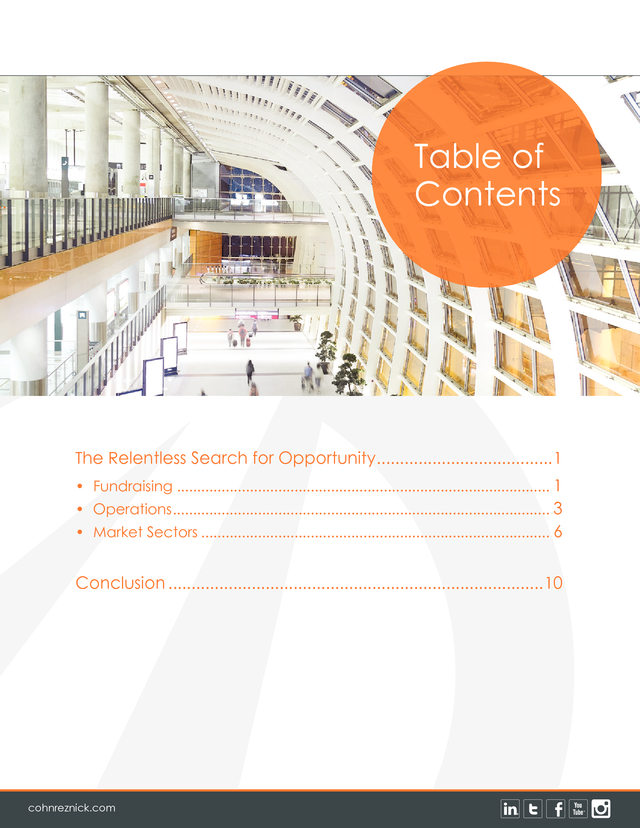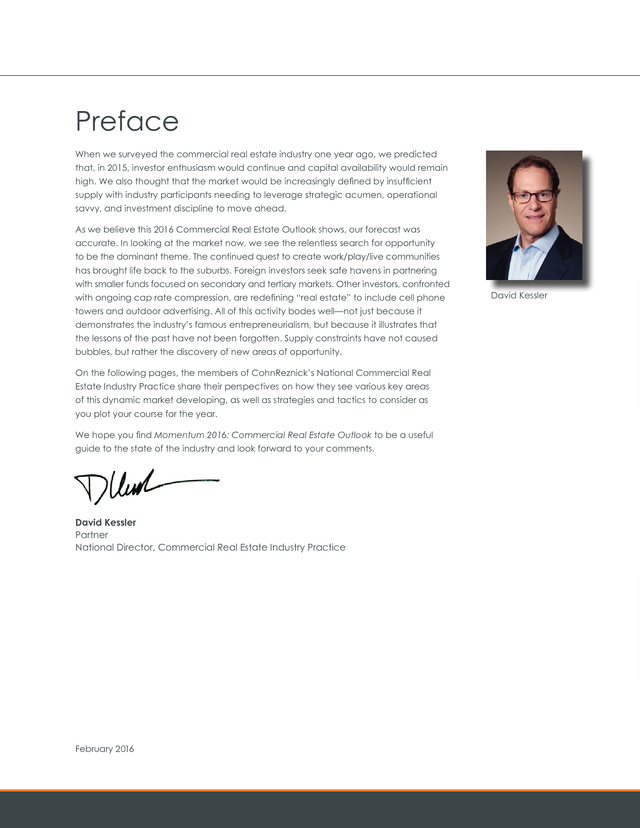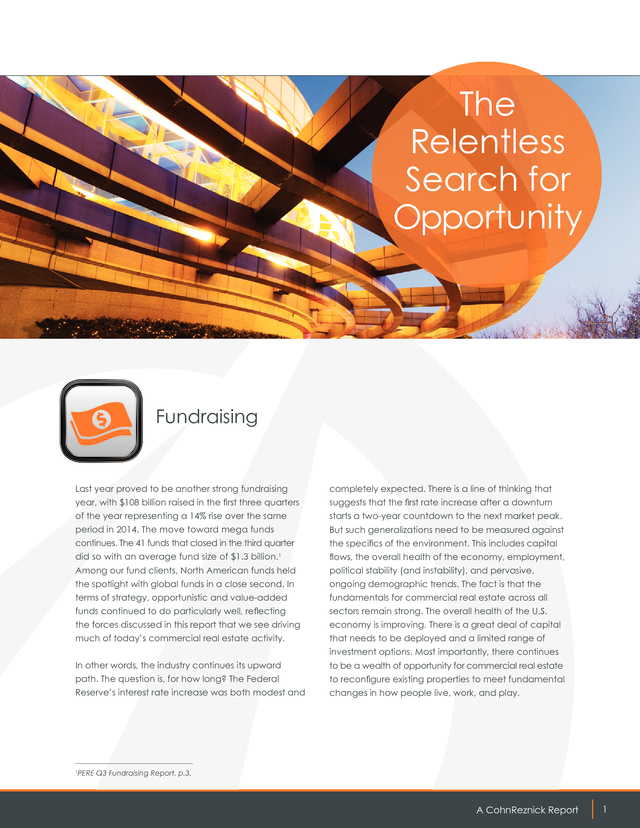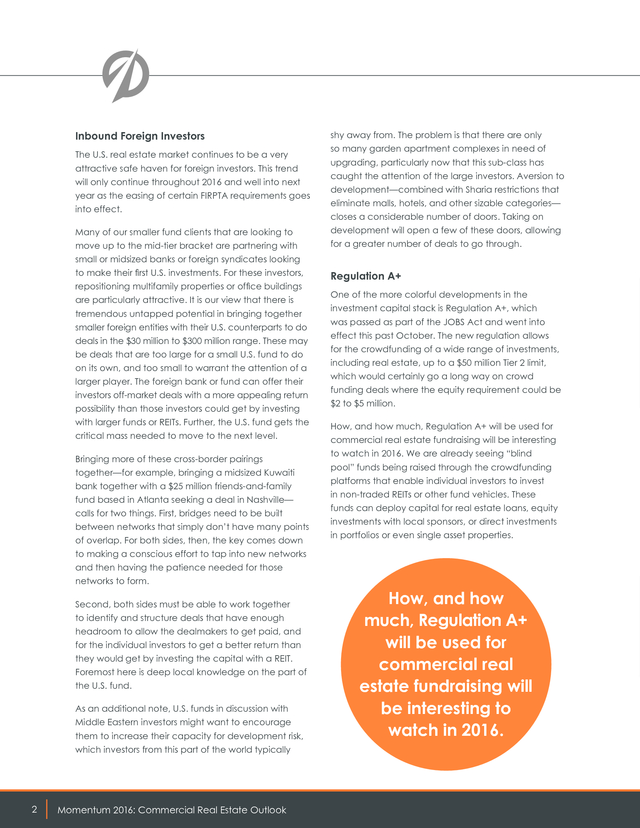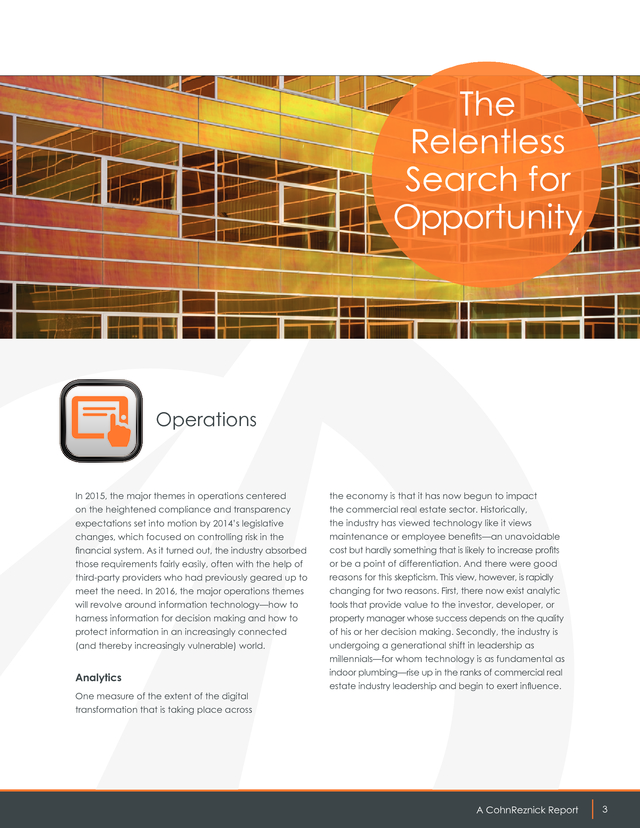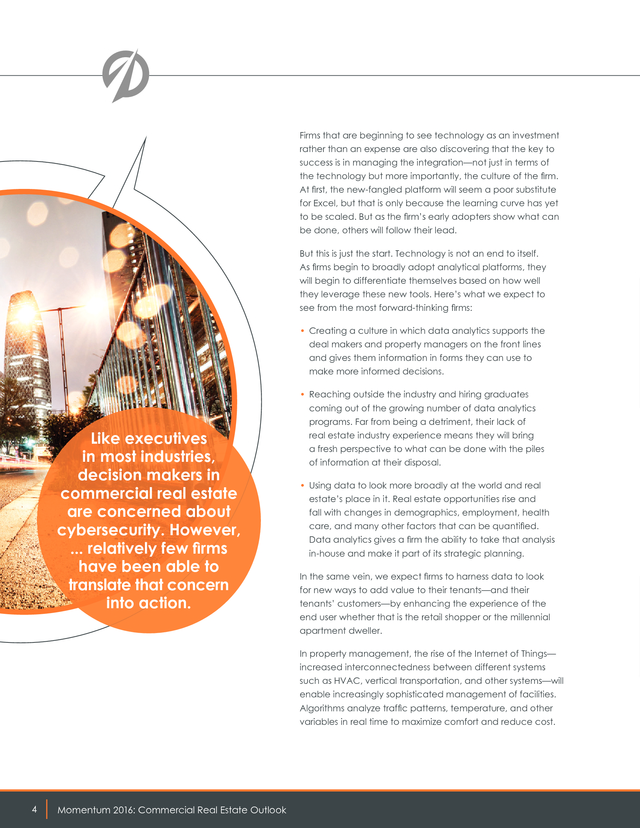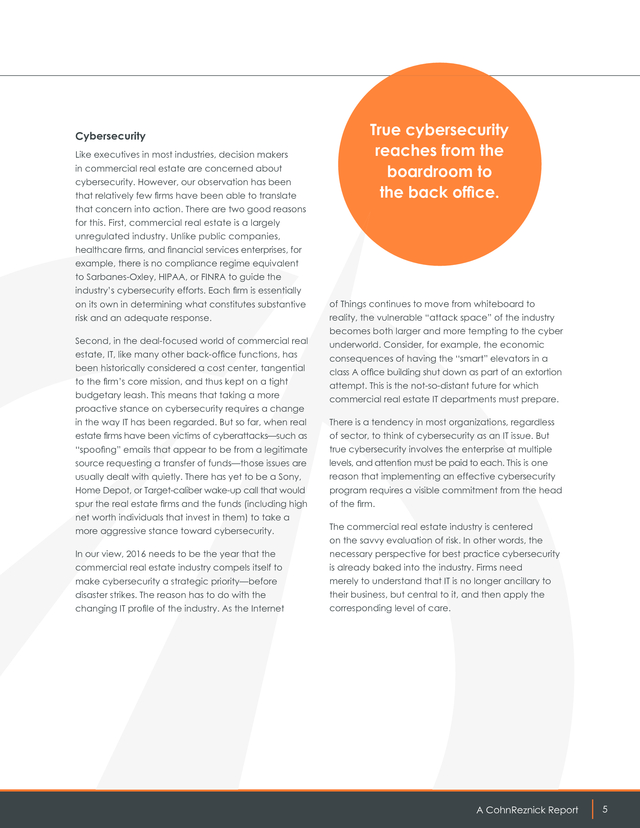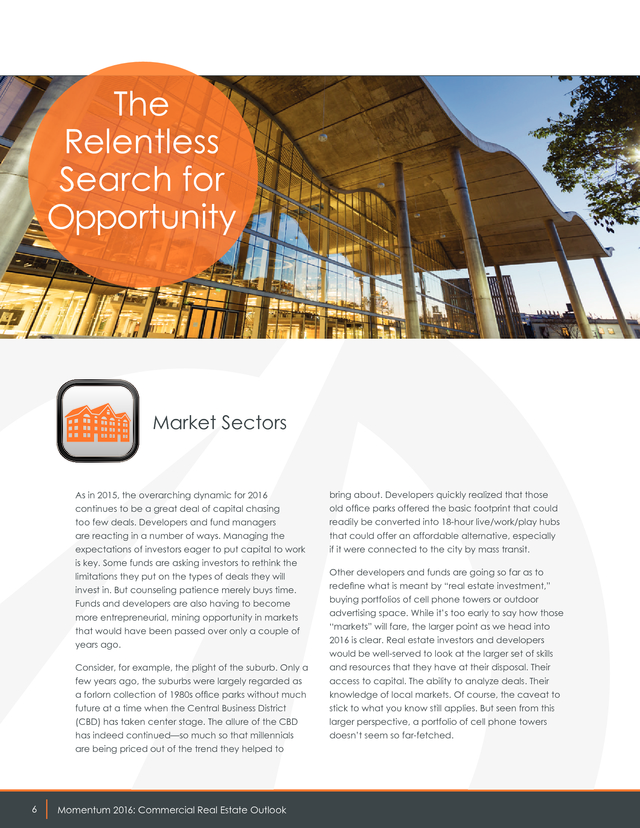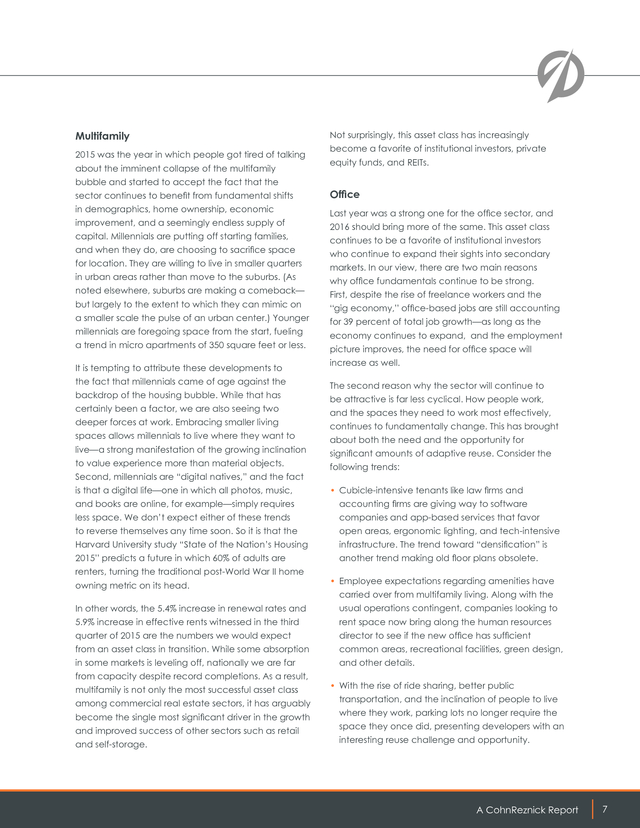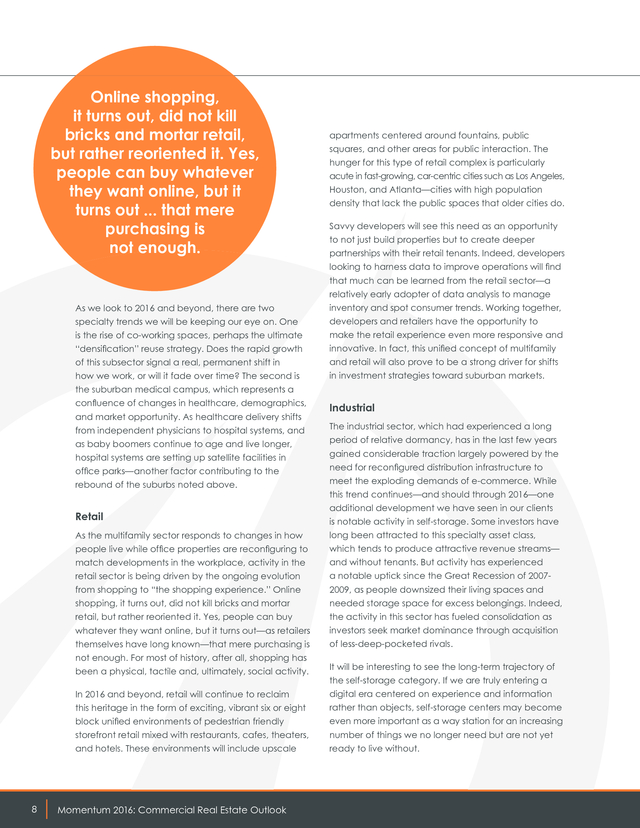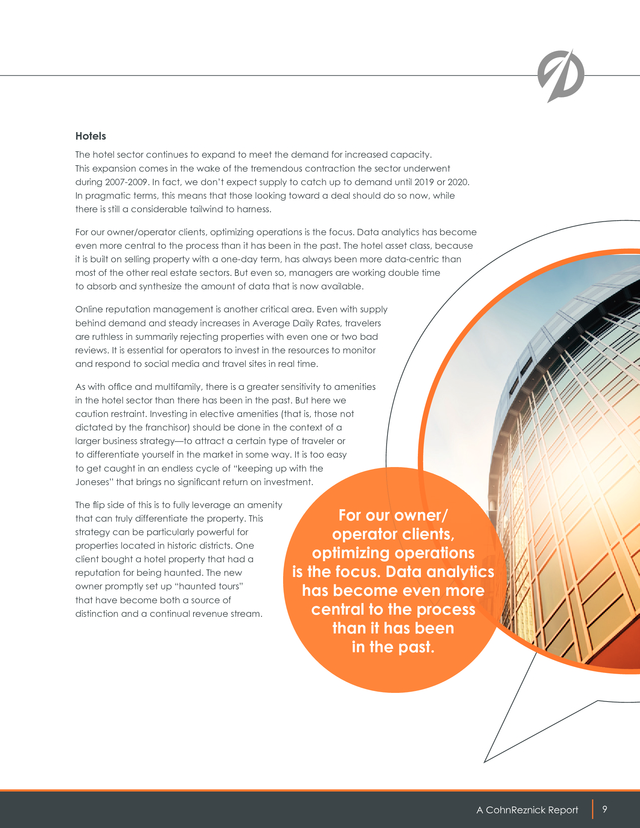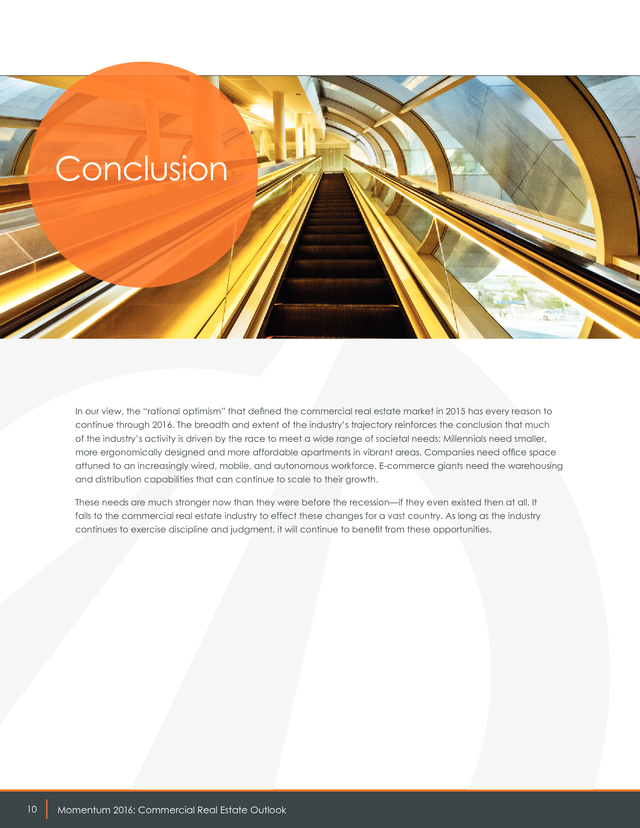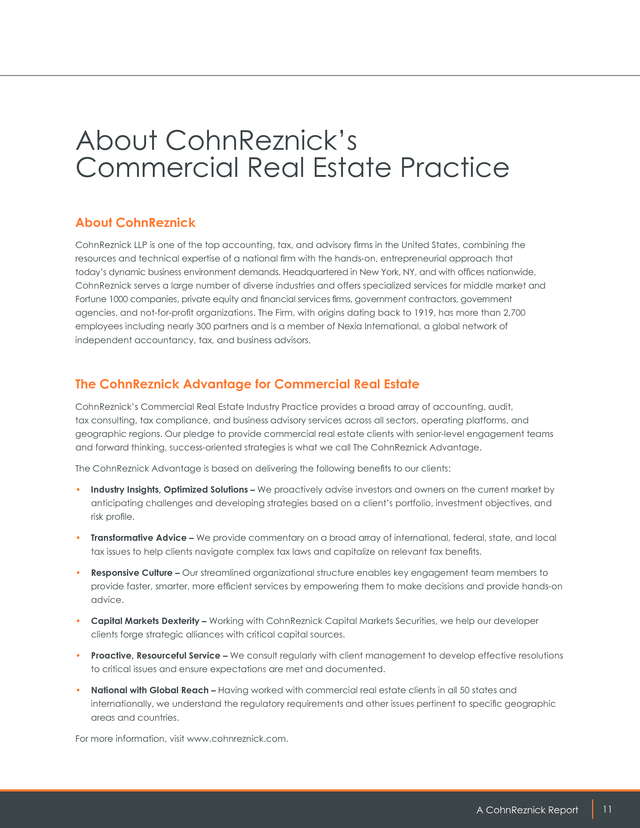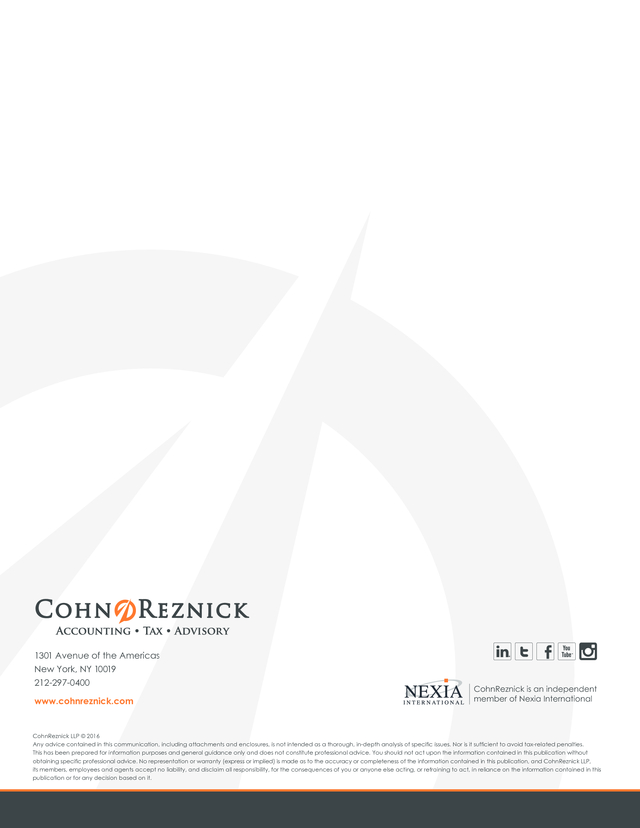Description
MOMENTUM 2016
Commercial
Real Estate
Outlook
A 2016 CohnReznick LLP Report
. Regulatory Issues...
6
mo • men • tum
noun: impetus and driving force gained by the
development of a process or course of events
. Table of
Contents
..
The Relentless Search for Opportunity ......................................1
• Fundraising ............................................................................................ 1
• Operations ............................................................................................. 3
• Market Sectors ...................................................................................... 6
Conclusion .................................................................................10
cohnreznick.com
A CohnReznick Report
3
.
Preface When we surveyed the commercial real estate industry one year ago, we predicted that, in 2015, investor enthusiasm would continue and capital availability would remain high. We also thought that the market would be increasingly defined by insufficient supply with industry participants needing to leverage strategic acumen, operational savvy, and investment discipline to move ahead. As we believe this 2016 Commercial Real Estate Outlook shows, our forecast was accurate. In looking at the market now, we see the relentless search for opportunity to be the dominant theme. The continued quest to create work/play/live communities has brought life back to the suburbs.
Foreign investors seek safe havens in partnering with smaller funds focused on secondary and tertiary markets. Other investors, confronted with ongoing cap rate compression, are redefining “real estate” to include cell phone towers and outdoor advertising. All of this activity bodes well—not just because it demonstrates the industry’s famous entrepreneurialism, but because it illustrates that the lessons of the past have not been forgotten.
Supply constraints have not caused bubbles, but rather the discovery of new areas of opportunity. On the following pages, the members of CohnReznick’s National Commercial Real Estate Industry Practice share their perspectives on how they see various key areas of this dynamic market developing, as well as strategies and tactics to consider as you plot your course for the year. We hope you find Momentum 2016: Commercial Real Estate Outlook to be a useful guide to the state of the industry and look forward to your comments. David Kessler Partner National Director, Commercial Real Estate Industry Practice February 2016 David Kessler . The Relentless Search for Opportunity Fundraising Last year proved to be another strong fundraising completely expected. There is a line of thinking that year, with $108 billion raised in the first three quarters suggests that the first rate increase after a downturn of the year representing a 14% rise over the same starts a two-year countdown to the next market peak. period in 2014. The move toward mega funds But such generalizations need to be measured against continues. The 41 funds that closed in the third quarter the specifics of the environment.
This includes capital did so with an average fund size of $1.3 billion.1 flows, the overall health of the economy, employment, Among our fund clients, North American funds held political stability (and instability), and pervasive, the spotlight with global funds in a close second. In ongoing demographic trends. The fact is that the terms of strategy, opportunistic and value-added fundamentals for commercial real estate across all funds continued to do particularly well, reflecting sectors remain strong.
The overall health of the U.S. the forces discussed in this report that we see driving economy is improving. There is a great deal of capital much of today’s commercial real estate activity. that needs to be deployed and a limited range of investment options. Most importantly, there continues In other words, the industry continues its upward to be a wealth of opportunity for commercial real estate path.
The question is, for how long? The Federal to reconfigure existing properties to meet fundamental Reserve’s interest rate increase was both modest and changes in how people live, work, and play. 1 PERE Q3 Fundraising Report, p.3. A CohnReznick Report 1 . Inbound Foreign Investors The U.S. real estate market continues to be a very attractive safe haven for foreign investors. This trend will only continue throughout 2016 and well into next year as the easing of certain FIRPTA requirements goes into effect. Many of our smaller fund clients that are looking to move up to the mid-tier bracket are partnering with shy away from. The problem is that there are only so many garden apartment complexes in need of upgrading, particularly now that this sub-class has caught the attention of the large investors.
Aversion to development—combined with Sharia restrictions that eliminate malls, hotels, and other sizable categories— closes a considerable number of doors. Taking on development will open a few of these doors, allowing for a greater number of deals to go through. small or midsized banks or foreign syndicates looking to make their first U.S. investments.
For these investors, repositioning multifamily properties or office buildings are particularly attractive. It is our view that there is tremendous untapped potential in bringing together smaller foreign entities with their U.S. counterparts to do deals in the $30 million to $300 million range.
These may be deals that are too large for a small U.S. fund to do on its own, and too small to warrant the attention of a larger player. The foreign bank or fund can offer their investors off-market deals with a more appealing return possibility than those investors could get by investing with larger funds or REITs.
Further, the U.S. fund gets the critical mass needed to move to the next level. Bringing more of these cross-border pairings together—for example, bringing a midsized Kuwaiti bank together with a $25 million friends-and-family fund based in Atlanta seeking a deal in Nashville— calls for two things. First, bridges need to be built between networks that simply don’t have many points of overlap.
For both sides, then, the key comes down Regulation A+ One of the more colorful developments in the investment capital stack is Regulation A+, which was passed as part of the JOBS Act and went into effect this past October. The new regulation allows for the crowdfunding of a wide range of investments, including real estate, up to a $50 million Tier 2 limit, which would certainly go a long way on crowd funding deals where the equity requirement could be $2 to $5 million. How, and how much, Regulation A+ will be used for commercial real estate fundraising will be interesting to watch in 2016. We are already seeing “blind pool” funds being raised through the crowdfunding platforms that enable individual investors to invest in non-traded REITs or other fund vehicles.
These funds can deploy capital for real estate loans, equity investments with local sponsors, or direct investments in portfolios or even single asset properties. to making a conscious effort to tap into new networks and then having the patience needed for those networks to form. Second, both sides must be able to work together to identify and structure deals that have enough headroom to allow the dealmakers to get paid, and for the individual investors to get a better return than they would get by investing the capital with a REIT. Foremost here is deep local knowledge on the part of the U.S. fund. As an additional note, U.S. funds in discussion with Middle Eastern investors might want to encourage them to increase their capacity for development risk, which investors from this part of the world typically 2 Momentum 2016: Commercial Real Estate Outlook How, and how much, Regulation A+ will be used for commercial real estate fundraising will be interesting to watch in 2016. .
The Relentless Search for Opportunity Operations In 2015, the major themes in operations centered the economy is that it has now begun to impact on the heightened compliance and transparency the commercial real estate sector. Historically, expectations set into motion by 2014’s legislative the industry has viewed technology like it views changes, which focused on controlling risk in the maintenance or employee benefits—an unavoidable financial system. As it turned out, the industry absorbed cost but hardly something that is likely to increase profits those requirements fairly easily, often with the help of or be a point of differentiation. And there were good third-party providers who had previously geared up to reasons for this skepticism.
This view, however, is rapidly meet the need. In 2016, the major operations themes changing for two reasons. First, there now exist analytic will revolve around information technology—how to tools that provide value to the investor, developer, or harness information for decision making and how to property manager whose success depends on the quality protect information in an increasingly connected of his or her decision making.
Secondly, the industry is (and thereby increasingly vulnerable) world. undergoing a generational shift in leadership as millennials—for whom technology is as fundamental as Analytics One measure of the extent of the digital indoor plumbing—rise up in the ranks of commercial real estate industry leadership and begin to exert influence. transformation that is taking place across A CohnReznick Report 3 . Firms that are beginning to see technology as an investment rather than an expense are also discovering that the key to success is in managing the integration—not just in terms of the technology but more importantly, the culture of the firm. At first, the new-fangled platform will seem a poor substitute for Excel, but that is only because the learning curve has yet to be scaled. But as the firm’s early adopters show what can be done, others will follow their lead. But this is just the start. Technology is not an end to itself. As firms begin to broadly adopt analytical platforms, they will begin to differentiate themselves based on how well they leverage these new tools. Here’s what we expect to see from the most forward-thinking firms: • Creating a culture in which data analytics supports the deal makers and property managers on the front lines and gives them information in forms they can use to make more informed decisions. • Reaching outside the industry and hiring graduates coming out of the growing number of data analytics Like executives in most industries, decision makers in commercial real estate are concerned about cybersecurity.
However, ... relatively few firms have been able to translate that concern into action. programs. Far from being a detriment, their lack of real estate industry experience means they will bring a fresh perspective to what can be done with the piles of information at their disposal. • Using data to look more broadly at the world and real estate’s place in it.
Real estate opportunities rise and fall with changes in demographics, employment, health care, and many other factors that can be quantified. Data analytics gives a firm the ability to take that analysis in-house and make it part of its strategic planning. In the same vein, we expect firms to harness data to look for new ways to add value to their tenants—and their tenants’ customers—by enhancing the experience of the end user whether that is the retail shopper or the millennial apartment dweller. In property management, the rise of the Internet of Things— increased interconnectedness between different systems such as HVAC, vertical transportation, and other systems—will enable increasingly sophisticated management of facilities. Algorithms analyze traffic patterns, temperature, and other variables in real time to maximize comfort and reduce cost. 4 Momentum 2016: Commercial Real Estate Outlook . Cybersecurity Like executives in most industries, decision makers in commercial real estate are concerned about cybersecurity. However, our observation has been that relatively few firms have been able to translate True cybersecurity reaches from the boardroom to the back office. that concern into action. There are two good reasons for this. First, commercial real estate is a largely unregulated industry.
Unlike public companies, healthcare firms, and financial services enterprises, for example, there is no compliance regime equivalent to Sarbanes-Oxley, HIPAA, or FINRA to guide the industry’s cybersecurity efforts. Each firm is essentially on its own in determining what constitutes substantive of Things continues to move from whiteboard to risk and an adequate response. reality, the vulnerable “attack space” of the industry Second, in the deal-focused world of commercial real estate, IT, like many other back-office functions, has been historically considered a cost center, tangential to the firm’s core mission, and thus kept on a tight budgetary leash. This means that taking a more proactive stance on cybersecurity requires a change becomes both larger and more tempting to the cyber underworld.
Consider, for example, the economic consequences of having the “smart” elevators in a class A office building shut down as part of an extortion attempt. This is the not-so-distant future for which commercial real estate IT departments must prepare. in the way IT has been regarded. But so far, when real There is a tendency in most organizations, regardless estate firms have been victims of cyberattacks—such as of sector, to think of cybersecurity as an IT issue.
But “spoofing” emails that appear to be from a legitimate true cybersecurity involves the enterprise at multiple source requesting a transfer of funds—those issues are levels, and attention must be paid to each. This is one usually dealt with quietly. There has yet to be a Sony, reason that implementing an effective cybersecurity Home Depot, or Target-caliber wake-up call that would program requires a visible commitment from the head spur the real estate firms and the funds (including high of the firm. net worth individuals that invest in them) to take a more aggressive stance toward cybersecurity. The commercial real estate industry is centered In our view, 2016 needs to be the year that the necessary perspective for best practice cybersecurity commercial real estate industry compels itself to is already baked into the industry.
Firms need make cybersecurity a strategic priority—before merely to understand that IT is no longer ancillary to disaster strikes. The reason has to do with the their business, but central to it, and then apply the changing IT profile of the industry. As the Internet corresponding level of care. on the savvy evaluation of risk.
In other words, the A CohnReznick Report 5 . The Relentless Search for Opportunity Market Sectors As in 2015, the overarching dynamic for 2016 bring about. Developers quickly realized that those continues to be a great deal of capital chasing old office parks offered the basic footprint that could too few deals. Developers and fund managers readily be converted into 18-hour live/work/play hubs are reacting in a number of ways. Managing the that could offer an affordable alternative, especially expectations of investors eager to put capital to work if it were connected to the city by mass transit. is key.
Some funds are asking investors to rethink the limitations they put on the types of deals they will invest in. But counseling patience merely buys time. Funds and developers are also having to become more entrepreneurial, mining opportunity in markets that would have been passed over only a couple of Other developers and funds are going so far as to redefine what is meant by “real estate investment,” buying portfolios of cell phone towers or outdoor advertising space. While it’s too early to say how those “markets” will fare, the larger point as we head into years ago. 2016 is clear.
Real estate investors and developers Consider, for example, the plight of the suburb. Only a and resources that they have at their disposal. Their few years ago, the suburbs were largely regarded as access to capital.
The ability to analyze deals. Their a forlorn collection of 1980s office parks without much knowledge of local markets. Of course, the caveat to future at a time when the Central Business District stick to what you know still applies.
But seen from this (CBD) has taken center stage. The allure of the CBD larger perspective, a portfolio of cell phone towers has indeed continued—so much so that millennials doesn’t seem so far-fetched. are being priced out of the trend they helped to 6 Momentum 2016: Commercial Real Estate Outlook would be well-served to look at the larger set of skills . Multifamily 2015 was the year in which people got tired of talking about the imminent collapse of the multifamily bubble and started to accept the fact that the Not surprisingly, this asset class has increasingly become a favorite of institutional investors, private equity funds, and REITs. sector continues to benefit from fundamental shifts Office in demographics, home ownership, economic Last year was a strong one for the office sector, and improvement, and a seemingly endless supply of capital. Millennials are putting off starting families, and when they do, are choosing to sacrifice space for location. They are willing to live in smaller quarters in urban areas rather than move to the suburbs. (As noted elsewhere, suburbs are making a comeback— but largely to the extent to which they can mimic on a smaller scale the pulse of an urban center.) Younger millennials are foregoing space from the start, fueling a trend in micro apartments of 350 square feet or less. It is tempting to attribute these developments to the fact that millennials came of age against the backdrop of the housing bubble.
While that has certainly been a factor, we are also seeing two deeper forces at work. Embracing smaller living spaces allows millennials to live where they want to live—a strong manifestation of the growing inclination to value experience more than material objects. Second, millennials are “digital natives,” and the fact is that a digital life—one in which all photos, music, 2016 should bring more of the same. This asset class continues to be a favorite of institutional investors who continue to expand their sights into secondary markets.
In our view, there are two main reasons why office fundamentals continue to be strong. First, despite the rise of freelance workers and the “gig economy,” office-based jobs are still accounting for 39 percent of total job growth—as long as the economy continues to expand, and the employment picture improves, the need for office space will increase as well. The second reason why the sector will continue to be attractive is far less cyclical. How people work, and the spaces they need to work most effectively, continues to fundamentally change. This has brought about both the need and the opportunity for significant amounts of adaptive reuse.
Consider the following trends: • Cubicle-intensive tenants like law firms and and books are online, for example—simply requires accounting firms are giving way to software less space. We don’t expect either of these trends companies and app-based services that favor to reverse themselves any time soon. So it is that the open areas, ergonomic lighting, and tech-intensive Harvard University study “State of the Nation’s Housing infrastructure.
The trend toward “densification” is 2015” predicts a future in which 60% of adults are another trend making old floor plans obsolete. renters, turning the traditional post-World War II home owning metric on its head. • Employee expectations regarding amenities have carried over from multifamily living. Along with the In other words, the 5.4% increase in renewal rates and usual operations contingent, companies looking to 5.9% increase in effective rents witnessed in the third rent space now bring along the human resources quarter of 2015 are the numbers we would expect director to see if the new office has sufficient from an asset class in transition. While some absorption common areas, recreational facilities, green design, in some markets is leveling off, nationally we are far and other details. from capacity despite record completions.
As a result, multifamily is not only the most successful asset class among commercial real estate sectors, it has arguably become the single most significant driver in the growth and improved success of other sectors such as retail and self-storage. • With the rise of ride sharing, better public transportation, and the inclination of people to live where they work, parking lots no longer require the space they once did, presenting developers with an interesting reuse challenge and opportunity. A CohnReznick Report 7 . Online shopping, it turns out, did not kill bricks and mortar retail, but rather reoriented it. Yes, people can buy whatever they want online, but it turns out ... that mere purchasing is not enough. apartments centered around fountains, public squares, and other areas for public interaction. The hunger for this type of retail complex is particularly acute in fast-growing, car-centric cities such as Los Angeles, Houston, and Atlanta—cities with high population density that lack the public spaces that older cities do. Savvy developers will see this need as an opportunity to not just build properties but to create deeper partnerships with their retail tenants.
Indeed, developers looking to harness data to improve operations will find that much can be learned from the retail sector—a relatively early adopter of data analysis to manage As we look to 2016 and beyond, there are two inventory and spot consumer trends. Working together, specialty trends we will be keeping our eye on. One developers and retailers have the opportunity to is the rise of co-working spaces, perhaps the ultimate make the retail experience even more responsive and “densification” reuse strategy.
Does the rapid growth innovative. In fact, this unified concept of multifamily of this subsector signal a real, permanent shift in and retail will also prove to be a strong driver for shifts how we work, or will it fade over time? The second is in investment strategies toward suburban markets. the suburban medical campus, which represents a confluence of changes in healthcare, demographics, and market opportunity. As healthcare delivery shifts from independent physicians to hospital systems, and as baby boomers continue to age and live longer, hospital systems are setting up satellite facilities in office parks—another factor contributing to the rebound of the suburbs noted above. Retail Industrial The industrial sector, which had experienced a long period of relative dormancy, has in the last few years gained considerable traction largely powered by the need for reconfigured distribution infrastructure to meet the exploding demands of e-commerce.
While this trend continues—and should through 2016—one additional development we have seen in our clients is notable activity in self-storage. Some investors have As the multifamily sector responds to changes in how long been attracted to this specialty asset class, people live while office properties are reconfiguring to which tends to produce attractive revenue streams— match developments in the workplace, activity in the and without tenants. But activity has experienced retail sector is being driven by the ongoing evolution a notable uptick since the Great Recession of 2007- from shopping to “the shopping experience.” Online 2009, as people downsized their living spaces and shopping, it turns out, did not kill bricks and mortar needed storage space for excess belongings.
Indeed, retail, but rather reoriented it. Yes, people can buy the activity in this sector has fueled consolidation as whatever they want online, but it turns out—as retailers investors seek market dominance through acquisition themselves have long known—that mere purchasing is of less-deep-pocketed rivals. not enough. For most of history, after all, shopping has been a physical, tactile and, ultimately, social activity. It will be interesting to see the long-term trajectory of the self-storage category.
If we are truly entering a In 2016 and beyond, retail will continue to reclaim this heritage in the form of exciting, vibrant six or eight rather than objects, self-storage centers may become block unified environments of pedestrian friendly even more important as a way station for an increasing storefront retail mixed with restaurants, cafes, theaters, number of things we no longer need but are not yet and hotels. These environments will include upscale 8 digital era centered on experience and information ready to live without. Momentum 2016: Commercial Real Estate Outlook . Hotels The hotel sector continues to expand to meet the demand for increased capacity. This expansion comes in the wake of the tremendous contraction the sector underwent during 2007-2009. In fact, we don’t expect supply to catch up to demand until 2019 or 2020. In pragmatic terms, this means that those looking toward a deal should do so now, while there is still a considerable tailwind to harness. For our owner/operator clients, optimizing operations is the focus. Data analytics has become even more central to the process than it has been in the past. The hotel asset class, because it is built on selling property with a one-day term, has always been more data-centric than most of the other real estate sectors.
But even so, managers are working double time to absorb and synthesize the amount of data that is now available. Online reputation management is another critical area. Even with supply behind demand and steady increases in Average Daily Rates, travelers are ruthless in summarily rejecting properties with even one or two bad reviews. It is essential for operators to invest in the resources to monitor and respond to social media and travel sites in real time. As with office and multifamily, there is a greater sensitivity to amenities in the hotel sector than there has been in the past.
But here we caution restraint. Investing in elective amenities (that is, those not dictated by the franchisor) should be done in the context of a larger business strategy—to attract a certain type of traveler or to differentiate yourself in the market in some way. It is too easy to get caught in an endless cycle of “keeping up with the Joneses” that brings no significant return on investment. The flip side of this is to fully leverage an amenity that can truly differentiate the property.
This strategy can be particularly powerful for properties located in historic districts. One client bought a hotel property that had a reputation for being haunted. The new owner promptly set up “haunted tours” that have become both a source of distinction and a continual revenue stream. For our owner/ operator clients, optimizing operations is the focus.
Data analytics has become even more central to the process than it has been in the past. A CohnReznick Report 9 . Conclusion In our view, the “rational optimism” that defined the commercial real estate market in 2015 has every reason to continue through 2016. The breadth and extent of the industry’s trajectory reinforces the conclusion that much of the industry’s activity is driven by the race to meet a wide range of societal needs: Millennials need smaller, more ergonomically designed and more affordable apartments in vibrant areas. Companies need office space attuned to an increasingly wired, mobile, and autonomous workforce. E-commerce giants need the warehousing and distribution capabilities that can continue to scale to their growth. These needs are much stronger now than they were before the recession—if they even existed then at all.
It falls to the commercial real estate industry to effect these changes for a vast country. As long as the industry continues to exercise discipline and judgment, it will continue to benefit from these opportunities. 10 Momentum 2016: Commercial Real Estate Outlook . About CohnReznick’s Commercial Real Estate Practice About CohnReznick CohnReznick LLP is one of the top accounting, tax, and advisory firms in the United States, combining the resources and technical expertise of a national firm with the hands-on, entrepreneurial approach that today’s dynamic business environment demands. Headquartered in New York, NY, and with offices nationwide, CohnReznick serves a large number of diverse industries and offers specialized services for middle market and Fortune 1000 companies, private equity and financial services firms, government contractors, government agencies, and not-for-profit organizations. The Firm, with origins dating back to 1919, has more than 2,700 employees including nearly 300 partners and is a member of Nexia International, a global network of independent accountancy, tax, and business advisors. The CohnReznick Advantage for Commercial Real Estate CohnReznick’s Commercial Real Estate Industry Practice provides a broad array of accounting, audit, tax consulting, tax compliance, and business advisory services across all sectors, operating platforms, and geographic regions. Our pledge to provide commercial real estate clients with senior-level engagement teams and forward thinking, success-oriented strategies is what we call The CohnReznick Advantage. The CohnReznick Advantage is based on delivering the following benefits to our clients: • Industry Insights, Optimized Solutions – We proactively advise investors and owners on the current market by anticipating challenges and developing strategies based on a client’s portfolio, investment objectives, and risk profile. • Transformative Advice – We provide commentary on a broad array of international, federal, state, and local tax issues to help clients navigate complex tax laws and capitalize on relevant tax benefits. • Responsive Culture – Our streamlined organizational structure enables key engagement team members to provide faster, smarter, more efficient services by empowering them to make decisions and provide hands-on advice. • Capital Markets Dexterity – Working with CohnReznick Capital Markets Securities, we help our developer clients forge strategic alliances with critical capital sources. • Proactive, Resourceful Service – We consult regularly with client management to develop effective resolutions to critical issues and ensure expectations are met and documented. • National with Global Reach – Having worked with commercial real estate clients in all 50 states and internationally, we understand the regulatory requirements and other issues pertinent to specific geographic areas and countries. For more information, visit www.cohnreznick.com. A CohnReznick Report 11 .
1301 Avenue of the Americas New York, NY 10019 212-297-0400 www.cohnreznick.com CohnReznick is an independent member of Nexia International CohnReznick LLP © 2016 Any advice contained in this communication, including attachments and enclosures, is not intended as a thorough, in-depth analysis of specific issues. Nor is it sufficient to avoid tax-related penalties. This has been prepared for information purposes and general guidance only and does not constitute professional advice. You should not act upon the information contained in this publication without obtaining specific professional advice. No representation or warranty (express or implied) is made as to the accuracy or completeness of the information contained in this publication, and CohnReznick LLP, its members, employees and agents accept no liability, and disclaim all responsibility, for the consequences of you or anyone else acting, or refraining to act, in reliance on the information contained in this publication or for any decision based on it. .
Preface When we surveyed the commercial real estate industry one year ago, we predicted that, in 2015, investor enthusiasm would continue and capital availability would remain high. We also thought that the market would be increasingly defined by insufficient supply with industry participants needing to leverage strategic acumen, operational savvy, and investment discipline to move ahead. As we believe this 2016 Commercial Real Estate Outlook shows, our forecast was accurate. In looking at the market now, we see the relentless search for opportunity to be the dominant theme. The continued quest to create work/play/live communities has brought life back to the suburbs.
Foreign investors seek safe havens in partnering with smaller funds focused on secondary and tertiary markets. Other investors, confronted with ongoing cap rate compression, are redefining “real estate” to include cell phone towers and outdoor advertising. All of this activity bodes well—not just because it demonstrates the industry’s famous entrepreneurialism, but because it illustrates that the lessons of the past have not been forgotten.
Supply constraints have not caused bubbles, but rather the discovery of new areas of opportunity. On the following pages, the members of CohnReznick’s National Commercial Real Estate Industry Practice share their perspectives on how they see various key areas of this dynamic market developing, as well as strategies and tactics to consider as you plot your course for the year. We hope you find Momentum 2016: Commercial Real Estate Outlook to be a useful guide to the state of the industry and look forward to your comments. David Kessler Partner National Director, Commercial Real Estate Industry Practice February 2016 David Kessler . The Relentless Search for Opportunity Fundraising Last year proved to be another strong fundraising completely expected. There is a line of thinking that year, with $108 billion raised in the first three quarters suggests that the first rate increase after a downturn of the year representing a 14% rise over the same starts a two-year countdown to the next market peak. period in 2014. The move toward mega funds But such generalizations need to be measured against continues. The 41 funds that closed in the third quarter the specifics of the environment.
This includes capital did so with an average fund size of $1.3 billion.1 flows, the overall health of the economy, employment, Among our fund clients, North American funds held political stability (and instability), and pervasive, the spotlight with global funds in a close second. In ongoing demographic trends. The fact is that the terms of strategy, opportunistic and value-added fundamentals for commercial real estate across all funds continued to do particularly well, reflecting sectors remain strong.
The overall health of the U.S. the forces discussed in this report that we see driving economy is improving. There is a great deal of capital much of today’s commercial real estate activity. that needs to be deployed and a limited range of investment options. Most importantly, there continues In other words, the industry continues its upward to be a wealth of opportunity for commercial real estate path.
The question is, for how long? The Federal to reconfigure existing properties to meet fundamental Reserve’s interest rate increase was both modest and changes in how people live, work, and play. 1 PERE Q3 Fundraising Report, p.3. A CohnReznick Report 1 . Inbound Foreign Investors The U.S. real estate market continues to be a very attractive safe haven for foreign investors. This trend will only continue throughout 2016 and well into next year as the easing of certain FIRPTA requirements goes into effect. Many of our smaller fund clients that are looking to move up to the mid-tier bracket are partnering with shy away from. The problem is that there are only so many garden apartment complexes in need of upgrading, particularly now that this sub-class has caught the attention of the large investors.
Aversion to development—combined with Sharia restrictions that eliminate malls, hotels, and other sizable categories— closes a considerable number of doors. Taking on development will open a few of these doors, allowing for a greater number of deals to go through. small or midsized banks or foreign syndicates looking to make their first U.S. investments.
For these investors, repositioning multifamily properties or office buildings are particularly attractive. It is our view that there is tremendous untapped potential in bringing together smaller foreign entities with their U.S. counterparts to do deals in the $30 million to $300 million range.
These may be deals that are too large for a small U.S. fund to do on its own, and too small to warrant the attention of a larger player. The foreign bank or fund can offer their investors off-market deals with a more appealing return possibility than those investors could get by investing with larger funds or REITs.
Further, the U.S. fund gets the critical mass needed to move to the next level. Bringing more of these cross-border pairings together—for example, bringing a midsized Kuwaiti bank together with a $25 million friends-and-family fund based in Atlanta seeking a deal in Nashville— calls for two things. First, bridges need to be built between networks that simply don’t have many points of overlap.
For both sides, then, the key comes down Regulation A+ One of the more colorful developments in the investment capital stack is Regulation A+, which was passed as part of the JOBS Act and went into effect this past October. The new regulation allows for the crowdfunding of a wide range of investments, including real estate, up to a $50 million Tier 2 limit, which would certainly go a long way on crowd funding deals where the equity requirement could be $2 to $5 million. How, and how much, Regulation A+ will be used for commercial real estate fundraising will be interesting to watch in 2016. We are already seeing “blind pool” funds being raised through the crowdfunding platforms that enable individual investors to invest in non-traded REITs or other fund vehicles.
These funds can deploy capital for real estate loans, equity investments with local sponsors, or direct investments in portfolios or even single asset properties. to making a conscious effort to tap into new networks and then having the patience needed for those networks to form. Second, both sides must be able to work together to identify and structure deals that have enough headroom to allow the dealmakers to get paid, and for the individual investors to get a better return than they would get by investing the capital with a REIT. Foremost here is deep local knowledge on the part of the U.S. fund. As an additional note, U.S. funds in discussion with Middle Eastern investors might want to encourage them to increase their capacity for development risk, which investors from this part of the world typically 2 Momentum 2016: Commercial Real Estate Outlook How, and how much, Regulation A+ will be used for commercial real estate fundraising will be interesting to watch in 2016. .
The Relentless Search for Opportunity Operations In 2015, the major themes in operations centered the economy is that it has now begun to impact on the heightened compliance and transparency the commercial real estate sector. Historically, expectations set into motion by 2014’s legislative the industry has viewed technology like it views changes, which focused on controlling risk in the maintenance or employee benefits—an unavoidable financial system. As it turned out, the industry absorbed cost but hardly something that is likely to increase profits those requirements fairly easily, often with the help of or be a point of differentiation. And there were good third-party providers who had previously geared up to reasons for this skepticism.
This view, however, is rapidly meet the need. In 2016, the major operations themes changing for two reasons. First, there now exist analytic will revolve around information technology—how to tools that provide value to the investor, developer, or harness information for decision making and how to property manager whose success depends on the quality protect information in an increasingly connected of his or her decision making.
Secondly, the industry is (and thereby increasingly vulnerable) world. undergoing a generational shift in leadership as millennials—for whom technology is as fundamental as Analytics One measure of the extent of the digital indoor plumbing—rise up in the ranks of commercial real estate industry leadership and begin to exert influence. transformation that is taking place across A CohnReznick Report 3 . Firms that are beginning to see technology as an investment rather than an expense are also discovering that the key to success is in managing the integration—not just in terms of the technology but more importantly, the culture of the firm. At first, the new-fangled platform will seem a poor substitute for Excel, but that is only because the learning curve has yet to be scaled. But as the firm’s early adopters show what can be done, others will follow their lead. But this is just the start. Technology is not an end to itself. As firms begin to broadly adopt analytical platforms, they will begin to differentiate themselves based on how well they leverage these new tools. Here’s what we expect to see from the most forward-thinking firms: • Creating a culture in which data analytics supports the deal makers and property managers on the front lines and gives them information in forms they can use to make more informed decisions. • Reaching outside the industry and hiring graduates coming out of the growing number of data analytics Like executives in most industries, decision makers in commercial real estate are concerned about cybersecurity.
However, ... relatively few firms have been able to translate that concern into action. programs. Far from being a detriment, their lack of real estate industry experience means they will bring a fresh perspective to what can be done with the piles of information at their disposal. • Using data to look more broadly at the world and real estate’s place in it.
Real estate opportunities rise and fall with changes in demographics, employment, health care, and many other factors that can be quantified. Data analytics gives a firm the ability to take that analysis in-house and make it part of its strategic planning. In the same vein, we expect firms to harness data to look for new ways to add value to their tenants—and their tenants’ customers—by enhancing the experience of the end user whether that is the retail shopper or the millennial apartment dweller. In property management, the rise of the Internet of Things— increased interconnectedness between different systems such as HVAC, vertical transportation, and other systems—will enable increasingly sophisticated management of facilities. Algorithms analyze traffic patterns, temperature, and other variables in real time to maximize comfort and reduce cost. 4 Momentum 2016: Commercial Real Estate Outlook . Cybersecurity Like executives in most industries, decision makers in commercial real estate are concerned about cybersecurity. However, our observation has been that relatively few firms have been able to translate True cybersecurity reaches from the boardroom to the back office. that concern into action. There are two good reasons for this. First, commercial real estate is a largely unregulated industry.
Unlike public companies, healthcare firms, and financial services enterprises, for example, there is no compliance regime equivalent to Sarbanes-Oxley, HIPAA, or FINRA to guide the industry’s cybersecurity efforts. Each firm is essentially on its own in determining what constitutes substantive of Things continues to move from whiteboard to risk and an adequate response. reality, the vulnerable “attack space” of the industry Second, in the deal-focused world of commercial real estate, IT, like many other back-office functions, has been historically considered a cost center, tangential to the firm’s core mission, and thus kept on a tight budgetary leash. This means that taking a more proactive stance on cybersecurity requires a change becomes both larger and more tempting to the cyber underworld.
Consider, for example, the economic consequences of having the “smart” elevators in a class A office building shut down as part of an extortion attempt. This is the not-so-distant future for which commercial real estate IT departments must prepare. in the way IT has been regarded. But so far, when real There is a tendency in most organizations, regardless estate firms have been victims of cyberattacks—such as of sector, to think of cybersecurity as an IT issue.
But “spoofing” emails that appear to be from a legitimate true cybersecurity involves the enterprise at multiple source requesting a transfer of funds—those issues are levels, and attention must be paid to each. This is one usually dealt with quietly. There has yet to be a Sony, reason that implementing an effective cybersecurity Home Depot, or Target-caliber wake-up call that would program requires a visible commitment from the head spur the real estate firms and the funds (including high of the firm. net worth individuals that invest in them) to take a more aggressive stance toward cybersecurity. The commercial real estate industry is centered In our view, 2016 needs to be the year that the necessary perspective for best practice cybersecurity commercial real estate industry compels itself to is already baked into the industry.
Firms need make cybersecurity a strategic priority—before merely to understand that IT is no longer ancillary to disaster strikes. The reason has to do with the their business, but central to it, and then apply the changing IT profile of the industry. As the Internet corresponding level of care. on the savvy evaluation of risk.
In other words, the A CohnReznick Report 5 . The Relentless Search for Opportunity Market Sectors As in 2015, the overarching dynamic for 2016 bring about. Developers quickly realized that those continues to be a great deal of capital chasing old office parks offered the basic footprint that could too few deals. Developers and fund managers readily be converted into 18-hour live/work/play hubs are reacting in a number of ways. Managing the that could offer an affordable alternative, especially expectations of investors eager to put capital to work if it were connected to the city by mass transit. is key.
Some funds are asking investors to rethink the limitations they put on the types of deals they will invest in. But counseling patience merely buys time. Funds and developers are also having to become more entrepreneurial, mining opportunity in markets that would have been passed over only a couple of Other developers and funds are going so far as to redefine what is meant by “real estate investment,” buying portfolios of cell phone towers or outdoor advertising space. While it’s too early to say how those “markets” will fare, the larger point as we head into years ago. 2016 is clear.
Real estate investors and developers Consider, for example, the plight of the suburb. Only a and resources that they have at their disposal. Their few years ago, the suburbs were largely regarded as access to capital.
The ability to analyze deals. Their a forlorn collection of 1980s office parks without much knowledge of local markets. Of course, the caveat to future at a time when the Central Business District stick to what you know still applies.
But seen from this (CBD) has taken center stage. The allure of the CBD larger perspective, a portfolio of cell phone towers has indeed continued—so much so that millennials doesn’t seem so far-fetched. are being priced out of the trend they helped to 6 Momentum 2016: Commercial Real Estate Outlook would be well-served to look at the larger set of skills . Multifamily 2015 was the year in which people got tired of talking about the imminent collapse of the multifamily bubble and started to accept the fact that the Not surprisingly, this asset class has increasingly become a favorite of institutional investors, private equity funds, and REITs. sector continues to benefit from fundamental shifts Office in demographics, home ownership, economic Last year was a strong one for the office sector, and improvement, and a seemingly endless supply of capital. Millennials are putting off starting families, and when they do, are choosing to sacrifice space for location. They are willing to live in smaller quarters in urban areas rather than move to the suburbs. (As noted elsewhere, suburbs are making a comeback— but largely to the extent to which they can mimic on a smaller scale the pulse of an urban center.) Younger millennials are foregoing space from the start, fueling a trend in micro apartments of 350 square feet or less. It is tempting to attribute these developments to the fact that millennials came of age against the backdrop of the housing bubble.
While that has certainly been a factor, we are also seeing two deeper forces at work. Embracing smaller living spaces allows millennials to live where they want to live—a strong manifestation of the growing inclination to value experience more than material objects. Second, millennials are “digital natives,” and the fact is that a digital life—one in which all photos, music, 2016 should bring more of the same. This asset class continues to be a favorite of institutional investors who continue to expand their sights into secondary markets.
In our view, there are two main reasons why office fundamentals continue to be strong. First, despite the rise of freelance workers and the “gig economy,” office-based jobs are still accounting for 39 percent of total job growth—as long as the economy continues to expand, and the employment picture improves, the need for office space will increase as well. The second reason why the sector will continue to be attractive is far less cyclical. How people work, and the spaces they need to work most effectively, continues to fundamentally change. This has brought about both the need and the opportunity for significant amounts of adaptive reuse.
Consider the following trends: • Cubicle-intensive tenants like law firms and and books are online, for example—simply requires accounting firms are giving way to software less space. We don’t expect either of these trends companies and app-based services that favor to reverse themselves any time soon. So it is that the open areas, ergonomic lighting, and tech-intensive Harvard University study “State of the Nation’s Housing infrastructure.
The trend toward “densification” is 2015” predicts a future in which 60% of adults are another trend making old floor plans obsolete. renters, turning the traditional post-World War II home owning metric on its head. • Employee expectations regarding amenities have carried over from multifamily living. Along with the In other words, the 5.4% increase in renewal rates and usual operations contingent, companies looking to 5.9% increase in effective rents witnessed in the third rent space now bring along the human resources quarter of 2015 are the numbers we would expect director to see if the new office has sufficient from an asset class in transition. While some absorption common areas, recreational facilities, green design, in some markets is leveling off, nationally we are far and other details. from capacity despite record completions.
As a result, multifamily is not only the most successful asset class among commercial real estate sectors, it has arguably become the single most significant driver in the growth and improved success of other sectors such as retail and self-storage. • With the rise of ride sharing, better public transportation, and the inclination of people to live where they work, parking lots no longer require the space they once did, presenting developers with an interesting reuse challenge and opportunity. A CohnReznick Report 7 . Online shopping, it turns out, did not kill bricks and mortar retail, but rather reoriented it. Yes, people can buy whatever they want online, but it turns out ... that mere purchasing is not enough. apartments centered around fountains, public squares, and other areas for public interaction. The hunger for this type of retail complex is particularly acute in fast-growing, car-centric cities such as Los Angeles, Houston, and Atlanta—cities with high population density that lack the public spaces that older cities do. Savvy developers will see this need as an opportunity to not just build properties but to create deeper partnerships with their retail tenants.
Indeed, developers looking to harness data to improve operations will find that much can be learned from the retail sector—a relatively early adopter of data analysis to manage As we look to 2016 and beyond, there are two inventory and spot consumer trends. Working together, specialty trends we will be keeping our eye on. One developers and retailers have the opportunity to is the rise of co-working spaces, perhaps the ultimate make the retail experience even more responsive and “densification” reuse strategy.
Does the rapid growth innovative. In fact, this unified concept of multifamily of this subsector signal a real, permanent shift in and retail will also prove to be a strong driver for shifts how we work, or will it fade over time? The second is in investment strategies toward suburban markets. the suburban medical campus, which represents a confluence of changes in healthcare, demographics, and market opportunity. As healthcare delivery shifts from independent physicians to hospital systems, and as baby boomers continue to age and live longer, hospital systems are setting up satellite facilities in office parks—another factor contributing to the rebound of the suburbs noted above. Retail Industrial The industrial sector, which had experienced a long period of relative dormancy, has in the last few years gained considerable traction largely powered by the need for reconfigured distribution infrastructure to meet the exploding demands of e-commerce.
While this trend continues—and should through 2016—one additional development we have seen in our clients is notable activity in self-storage. Some investors have As the multifamily sector responds to changes in how long been attracted to this specialty asset class, people live while office properties are reconfiguring to which tends to produce attractive revenue streams— match developments in the workplace, activity in the and without tenants. But activity has experienced retail sector is being driven by the ongoing evolution a notable uptick since the Great Recession of 2007- from shopping to “the shopping experience.” Online 2009, as people downsized their living spaces and shopping, it turns out, did not kill bricks and mortar needed storage space for excess belongings.
Indeed, retail, but rather reoriented it. Yes, people can buy the activity in this sector has fueled consolidation as whatever they want online, but it turns out—as retailers investors seek market dominance through acquisition themselves have long known—that mere purchasing is of less-deep-pocketed rivals. not enough. For most of history, after all, shopping has been a physical, tactile and, ultimately, social activity. It will be interesting to see the long-term trajectory of the self-storage category.
If we are truly entering a In 2016 and beyond, retail will continue to reclaim this heritage in the form of exciting, vibrant six or eight rather than objects, self-storage centers may become block unified environments of pedestrian friendly even more important as a way station for an increasing storefront retail mixed with restaurants, cafes, theaters, number of things we no longer need but are not yet and hotels. These environments will include upscale 8 digital era centered on experience and information ready to live without. Momentum 2016: Commercial Real Estate Outlook . Hotels The hotel sector continues to expand to meet the demand for increased capacity. This expansion comes in the wake of the tremendous contraction the sector underwent during 2007-2009. In fact, we don’t expect supply to catch up to demand until 2019 or 2020. In pragmatic terms, this means that those looking toward a deal should do so now, while there is still a considerable tailwind to harness. For our owner/operator clients, optimizing operations is the focus. Data analytics has become even more central to the process than it has been in the past. The hotel asset class, because it is built on selling property with a one-day term, has always been more data-centric than most of the other real estate sectors.
But even so, managers are working double time to absorb and synthesize the amount of data that is now available. Online reputation management is another critical area. Even with supply behind demand and steady increases in Average Daily Rates, travelers are ruthless in summarily rejecting properties with even one or two bad reviews. It is essential for operators to invest in the resources to monitor and respond to social media and travel sites in real time. As with office and multifamily, there is a greater sensitivity to amenities in the hotel sector than there has been in the past.
But here we caution restraint. Investing in elective amenities (that is, those not dictated by the franchisor) should be done in the context of a larger business strategy—to attract a certain type of traveler or to differentiate yourself in the market in some way. It is too easy to get caught in an endless cycle of “keeping up with the Joneses” that brings no significant return on investment. The flip side of this is to fully leverage an amenity that can truly differentiate the property.
This strategy can be particularly powerful for properties located in historic districts. One client bought a hotel property that had a reputation for being haunted. The new owner promptly set up “haunted tours” that have become both a source of distinction and a continual revenue stream. For our owner/ operator clients, optimizing operations is the focus.
Data analytics has become even more central to the process than it has been in the past. A CohnReznick Report 9 . Conclusion In our view, the “rational optimism” that defined the commercial real estate market in 2015 has every reason to continue through 2016. The breadth and extent of the industry’s trajectory reinforces the conclusion that much of the industry’s activity is driven by the race to meet a wide range of societal needs: Millennials need smaller, more ergonomically designed and more affordable apartments in vibrant areas. Companies need office space attuned to an increasingly wired, mobile, and autonomous workforce. E-commerce giants need the warehousing and distribution capabilities that can continue to scale to their growth. These needs are much stronger now than they were before the recession—if they even existed then at all.
It falls to the commercial real estate industry to effect these changes for a vast country. As long as the industry continues to exercise discipline and judgment, it will continue to benefit from these opportunities. 10 Momentum 2016: Commercial Real Estate Outlook . About CohnReznick’s Commercial Real Estate Practice About CohnReznick CohnReznick LLP is one of the top accounting, tax, and advisory firms in the United States, combining the resources and technical expertise of a national firm with the hands-on, entrepreneurial approach that today’s dynamic business environment demands. Headquartered in New York, NY, and with offices nationwide, CohnReznick serves a large number of diverse industries and offers specialized services for middle market and Fortune 1000 companies, private equity and financial services firms, government contractors, government agencies, and not-for-profit organizations. The Firm, with origins dating back to 1919, has more than 2,700 employees including nearly 300 partners and is a member of Nexia International, a global network of independent accountancy, tax, and business advisors. The CohnReznick Advantage for Commercial Real Estate CohnReznick’s Commercial Real Estate Industry Practice provides a broad array of accounting, audit, tax consulting, tax compliance, and business advisory services across all sectors, operating platforms, and geographic regions. Our pledge to provide commercial real estate clients with senior-level engagement teams and forward thinking, success-oriented strategies is what we call The CohnReznick Advantage. The CohnReznick Advantage is based on delivering the following benefits to our clients: • Industry Insights, Optimized Solutions – We proactively advise investors and owners on the current market by anticipating challenges and developing strategies based on a client’s portfolio, investment objectives, and risk profile. • Transformative Advice – We provide commentary on a broad array of international, federal, state, and local tax issues to help clients navigate complex tax laws and capitalize on relevant tax benefits. • Responsive Culture – Our streamlined organizational structure enables key engagement team members to provide faster, smarter, more efficient services by empowering them to make decisions and provide hands-on advice. • Capital Markets Dexterity – Working with CohnReznick Capital Markets Securities, we help our developer clients forge strategic alliances with critical capital sources. • Proactive, Resourceful Service – We consult regularly with client management to develop effective resolutions to critical issues and ensure expectations are met and documented. • National with Global Reach – Having worked with commercial real estate clients in all 50 states and internationally, we understand the regulatory requirements and other issues pertinent to specific geographic areas and countries. For more information, visit www.cohnreznick.com. A CohnReznick Report 11 .
1301 Avenue of the Americas New York, NY 10019 212-297-0400 www.cohnreznick.com CohnReznick is an independent member of Nexia International CohnReznick LLP © 2016 Any advice contained in this communication, including attachments and enclosures, is not intended as a thorough, in-depth analysis of specific issues. Nor is it sufficient to avoid tax-related penalties. This has been prepared for information purposes and general guidance only and does not constitute professional advice. You should not act upon the information contained in this publication without obtaining specific professional advice. No representation or warranty (express or implied) is made as to the accuracy or completeness of the information contained in this publication, and CohnReznick LLP, its members, employees and agents accept no liability, and disclaim all responsibility, for the consequences of you or anyone else acting, or refraining to act, in reliance on the information contained in this publication or for any decision based on it. .





